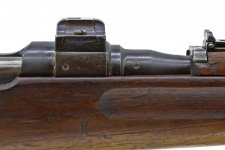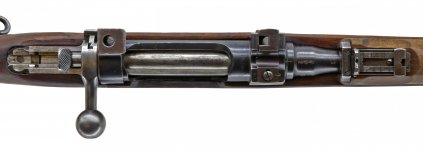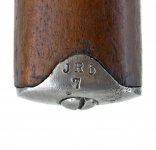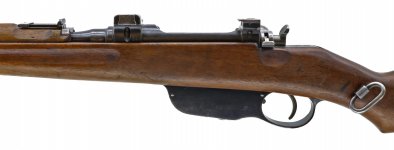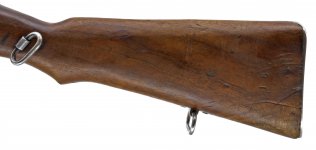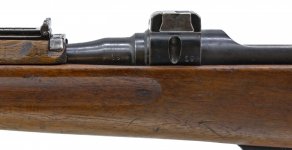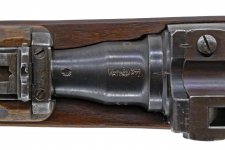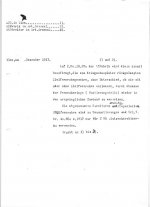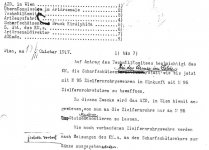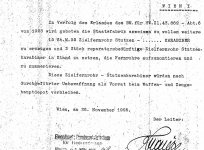Absolut
Senior Member
While surely not the main focus of this forum, the reason why I posted it here: it most possibly was handed out to the Volkssturm at the end of WWII since it was found among German equipment (gas masks, ammo, etc.), well hidden in an Austrian attic until this summer.
This rifle is a Stutzenkarabiner Sniper rifle and has a very interesting history:
In the inter-war period Austria gave order to count the weapons they have, especially regarding sniper rifles. They received back charts that contained Zielfernrohrgewehre ("sniper rifles"), Zielfernrohrstutzenkarabiner ("sniper carbines"; "Stutzenkarabiner" is the carbine with swivels both on bottom and on the side) and Zielfernrohrstutzen (also "sniper carbine", but "Stutzen" means swivels only on bottom of the stock). The equipment however should only consist of Zielfernrohrstutzenkarabiner, so sniper carbines with swivels both on the side and on bottom. Therefore the Zielfernrohrgewehre had to be sent to the Waffen- und Zeughauptdepot ("gun and equipment main depot") in exchange for Zielfernrohrstutzenkarabiner. The Zielfernrohrstutzen however had to be converted to -Stutzenkarabiner by the Waffenmeister (gunsmiths of the Army). The parts required for this conversion were supplied to the Waffenmeister by the Waffen- und Zeughauptdepot. At the same time the Waffen- und Zeughauptdepot were ordered to set up 145 Zielfernrohrstutzenkarabiner.
The particular rifle features scope bases that have the internal AZF assembly number they got when issued in WWI still on them, additionally the newly given serial number #18. The original AZF mount assembly number make it obvious the bases already originate from either a Stutzen or a Stutzenkarabiner and therefore are parts re-used from a WWI sniper rifle. It however cannot be said for certain whether the rifle is a Waffenmeister conversion from Zielfernrohrstutzen to Zielfernrohrstutzenkarabiner, or a newly set up Zielfernrohrstutzenkarabiner by the Waffen- und Zeughauptdepot. Based on the very low serial number I however tend to assume it is more likely this rifle was set up by the Waffen- und Zeughauptdepot, since the Waffenmeister would not change over the serial to a new one.
Worth mentioning in this context are the barrel shank stamps. Note the rifle originally carried what appears to be a Wn?5 proof, therefore most likely Wn15, that would indicate the rifle being originally proofed in Vienna in 1915. This then got overstamped HV25 for HeeresVerwaltung 1925, an Austrian repair stamp withmost possibly the date the rifle got changed over to Zielfernrohrstutzenkarabiner. This stamp however is overstamped a third time with what reads 27 - what means it was repaired again in 1927! The second repair very well could also had been a minor repair, such as a change of the scope only, since the huge mixture of various scope manufacturers with many of them requiring repair was another problem Austria faced post WWI.
The caliber of this rifle is still 8x50R since the Army was not happy with the accuracy of the S-Patrone (or "8x56R" caliber). In fact the sniper rifles at least up to 1936 never got converted to 8x56R. On 1st May 1936 the Staatsfabrik ("Government Factory") was ordered to set up 4 M.17/30 rifles as well as 4 "8mm M.95 S-Stutzen" (8x56R converted carbines) with scope in "neuer Befestigungsart" ("new mount style"). This trials confirmed a worse accuracy of the S-caliber, despite the rifles for this experiment were hand selected. Since the request for new sniper rifles to be M.17/30 got neglected due to high costs, at least up to end 1937/beginning 1938 only these trials sniper rifles were in S-Patrone/8x56R caliber. At around this period the "neue Befestigungsart" got approved, but was soon stopped since Austria was occupied by Germany.
This rifle is a Stutzenkarabiner Sniper rifle and has a very interesting history:
In the inter-war period Austria gave order to count the weapons they have, especially regarding sniper rifles. They received back charts that contained Zielfernrohrgewehre ("sniper rifles"), Zielfernrohrstutzenkarabiner ("sniper carbines"; "Stutzenkarabiner" is the carbine with swivels both on bottom and on the side) and Zielfernrohrstutzen (also "sniper carbine", but "Stutzen" means swivels only on bottom of the stock). The equipment however should only consist of Zielfernrohrstutzenkarabiner, so sniper carbines with swivels both on the side and on bottom. Therefore the Zielfernrohrgewehre had to be sent to the Waffen- und Zeughauptdepot ("gun and equipment main depot") in exchange for Zielfernrohrstutzenkarabiner. The Zielfernrohrstutzen however had to be converted to -Stutzenkarabiner by the Waffenmeister (gunsmiths of the Army). The parts required for this conversion were supplied to the Waffenmeister by the Waffen- und Zeughauptdepot. At the same time the Waffen- und Zeughauptdepot were ordered to set up 145 Zielfernrohrstutzenkarabiner.
The particular rifle features scope bases that have the internal AZF assembly number they got when issued in WWI still on them, additionally the newly given serial number #18. The original AZF mount assembly number make it obvious the bases already originate from either a Stutzen or a Stutzenkarabiner and therefore are parts re-used from a WWI sniper rifle. It however cannot be said for certain whether the rifle is a Waffenmeister conversion from Zielfernrohrstutzen to Zielfernrohrstutzenkarabiner, or a newly set up Zielfernrohrstutzenkarabiner by the Waffen- und Zeughauptdepot. Based on the very low serial number I however tend to assume it is more likely this rifle was set up by the Waffen- und Zeughauptdepot, since the Waffenmeister would not change over the serial to a new one.
Worth mentioning in this context are the barrel shank stamps. Note the rifle originally carried what appears to be a Wn?5 proof, therefore most likely Wn15, that would indicate the rifle being originally proofed in Vienna in 1915. This then got overstamped HV25 for HeeresVerwaltung 1925, an Austrian repair stamp withmost possibly the date the rifle got changed over to Zielfernrohrstutzenkarabiner. This stamp however is overstamped a third time with what reads 27 - what means it was repaired again in 1927! The second repair very well could also had been a minor repair, such as a change of the scope only, since the huge mixture of various scope manufacturers with many of them requiring repair was another problem Austria faced post WWI.
The caliber of this rifle is still 8x50R since the Army was not happy with the accuracy of the S-Patrone (or "8x56R" caliber). In fact the sniper rifles at least up to 1936 never got converted to 8x56R. On 1st May 1936 the Staatsfabrik ("Government Factory") was ordered to set up 4 M.17/30 rifles as well as 4 "8mm M.95 S-Stutzen" (8x56R converted carbines) with scope in "neuer Befestigungsart" ("new mount style"). This trials confirmed a worse accuracy of the S-caliber, despite the rifles for this experiment were hand selected. Since the request for new sniper rifles to be M.17/30 got neglected due to high costs, at least up to end 1937/beginning 1938 only these trials sniper rifles were in S-Patrone/8x56R caliber. At around this period the "neue Befestigungsart" got approved, but was soon stopped since Austria was occupied by Germany.




